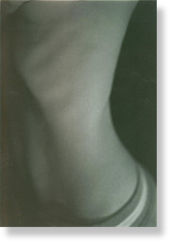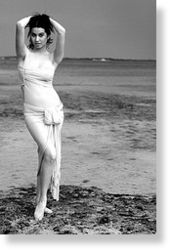
© Flickr
"We live in an age where we are surrounded by an image of an ideal body shape, communicated by a constantly evolving media....Much of what we see is a fusion of reality and fantasy, with many of the images presented to us having been altered or enhanced in some way" (Sanger, 2007). Our media is full of body images that create in many cases very unattainable and distorted body ideals that are directed at gregarious women.
Anxiety, depression, obsessive behavior, social isolation, irritability, suicidal tendencies, eating disorders (e.g. anorexia nervosa, bulimia or excessive dieting), lack of assertiveness, guilt, self-dislike, excessive plastic operation
are all symptoms of the pressures that body perfect images place on people. Between 70 - 76% of Australian high school girls consistently choose an ideal figure that they wish to have that is thinner than their own and only 16% of young women are happy with their body weight with eating disorders affecting about 5% of the female population in Australia (Sanger, 2007). It is clear that the biggest problem with societal expectations of attractiveness is the impact it makes on women's perception of themselves and their self esteem.
NSW Health Summit (1996) has shown that there is a lack of larger model sizes, the media's feminine image does not truly represent the image of over 65% of women, there are conflicting up-front and subliminal messages in magazines linked to hidden interests with extraordinary profits idealizing thin bodies that portray youth, positive social and family lifestyles.

© Flickr
The constant bombardment of body perfect promotes ideals as healthy, sexy, successful, popular, cool, and edgy. In reality, many of these body ideals are unrealistic to the average woman. Unrealistic standards for behavior and appearance produce physical and emotional damage by causing eating disorders, excessive use of plastic surgery, malnutrition, and emotional problems that negatively affects moods and take away energy from pursuing more confidence building activities. In a society where women are excessively obsessed with their image, their priority, focus, body language, values and internal and external languages are affected. Perfectionism, denial, and dualistic thinking are all part of an addictive system (
Northrup, 1998) that disempowers women and further prolongs the 'Beauty Myth', that is the belief in an objective quality called beauty that keeps male dominance intact by perpetuating women's insecurity about their appearance (
Wolf, 1991).
An increasing number of older women in media strive to attain younger looking bodies through excessive use of plastic operations. The law of nature clearly shows that change is the essence of our existence, as old needs to be replaced with new. Nature contains mechanisms of growth and decay where life is about growing, changing, moving, creating each and every day. Instead of getting upset about our youthful and energetic bodies turning into a collection of degenerating cells we should realize that this is how it is supposed to be.
Inability to acknowledge and accept this, produces imbalances in and out of our physical and mental realms.
Social desire for a perfect body can be understandable however this should not in any way affect the respect or love for one's own body. Whenever women compare themselves to icons of perfection, it is normally done via a negative comparison, for example, "my nose isn't good enough" or "my hips are too wide". In reality, it is very easy to feel fat and ugly when comparing yourself to unrealistic ideals. Feelings of inferiority, inadequacy of appearance, non-acceptance and disrespect for one's body is what produces the "I'm not good enough" mentality, shown to be related to gallbladder, pancreas problems and other women's emotional and eating issues. (
Northrup, 1998)
We must all realize that we have been dehumanized to a point where we have stopped valuing our bodies. Our bodies have become just scientific objects that can be manipulated, cut, replaced, and stripped of all their uniqueness, sacredness and mystery. As long as 'focus-on-image' dominates decision-making in women's lives, women will continue to enslave and imprison themselves in a compulsive pursuit of beauty as a tyrannical and seductive trap, with serious implications in areas of self esteem, self hate and narcissism.
According to
Northrup (1998), women should become aware that the overall wellness is more important than just beauty. This starts by asking serious questions about one's health,
dealing with the past, releasing negative emotions, respecting and acknowledging a higher wisdom.Maintaining a positive outlook on life is important but we cannot allow ourselves to fall into the trap of becoming positively blind, so becoming sentient to all aspects of life is vital, especially to other interests at play. Ignorance is not bliss so seek help when needed, by being honest with yourself. Work with your body, gather information, work on forgiveness and actively participate in your life.
ReferencesNorthrup, C. (1998).
Women's Bodies, Women's Wisdom - Creating Physical and Emotional Health and Healing. New York, NY: Bantam Books.
NSW Health Summit (1996)
Caring for Health, Ministerial Summit on Body Image and Eating Disorders. State Health Publication. NSW Goverment Publication. #PHD970018, ISBN 07310 92759
Sanger, L. (2007).
Conduct on Body Image Working Group - Final Report July 2007. Melbourne, VIC: Ministerial Media Code.
The Butterfly Foundation. (n.d.).
Supporting Australian with Eating Disorders. Retrived December, 10, 2010 from
here.
Wolf, N. (1991).
The Beauty Myth: How Images of Beauty Are Used Against Women. New York, NY: William Morrow.
Comment: Indeed. Éiriú Eolas is a powerful meditation and de-stressing program that can greatly help to detoxify the body and the mind.